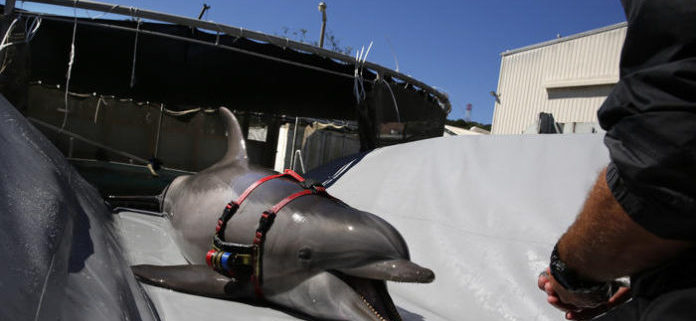Navy Dolphins Are Helping To Save The Critically Endangered Vaquita Porpoise
Dolphins who are a part of the U.S. Navy Marine Mammal Program will be helping the U.S Navy with a new mission which is to save the critically endangered population of vaquitas from becoming extinct.
Vaquitas are a small porpoise that lives only in the rich and turbid waters of the Upper Gulf of California. The animals, which must surface to breathe, not only are rare but also extremely shy and difficult to spot, as they splash little, travel in small groups and avoid boats.
Although this has never before been accomplished, the dolphins’ duty will be to locate some of the few surviving vaquita porpoises in Mexico’s Upper Gulf of California by being assembled into teams on both sides of the border and aimed at capturing the threatened vaquitas.
This expedition represents a final hope to an international group of scientists who are determined to save the species from near-certain extinction. Scientists say the vaquita population has dwindled over the past two decades — from 567 in an initial survey in 1997 to fewer than 60.
The fall in population numbers has much to do with the the rampant illegal fishery for totoaba, a large fish whose swim bladders fetch exorbitant prices in China. Vaquitas are often caught in gill-nets used to capture the totoaba who share the porpoise’s habitat.
In April 2015, Mexican President Enrique Peña Nieto’s administration launched a two year plan that would expand a ban on gill-net fishing, however vaquita population numbers continued to drop. This is why a new approach to save the species has been deemed vital.
Mexico’s Secretariat of Environment and Natural Resources are the ones to spearhead the plan which involves removing vaquitas from the open water in their habitat in the Upper Gulf of California and keeping them safe from illegal gill nets, where they often end up as by-catch and drown.
A group of experts, including porpoise and veterinary care specialists, are expected to attempt the capture in the spring.
The operation “has to be done in a very careful, staged manner,” said Barbara Taylor, a conservation biologist at the National Oceanic and Atmospheric Administration’s Southwest Fisheries Science Center in La Jolla.
The operation which is planed for May, would entail placing vaquitas inside a protective pen off the coast of San Felipe, with the hope that they will have a better chance for survival and may even naturally breed and reproduce. This plan would be the latest in a series of efforts aimed at protecting vaquitas.
“We can’t afford to be slow about this,” Taylor said. “We have to give this our mightiest effort as quickly as possible.”
The Navy Marine Mammal Program uses dolphins to help find and remove underwater mines as well as to detect clandestine swimmers and divers in restricted areas because they are skilled at locating things beneath the surface through echolocation, or sonar, which allows them to interpret the echoes of sound waves, as well as through their capacity for directional hearing underwater.
NOAA’s Taylor said even as the vaquita capture plan moves forward, enforcement efforts and other programs also must continue. “It’s not a situation where you can give up on enforcement, and give up on getting nets out of the water.”
Source: Los Angeles Times






